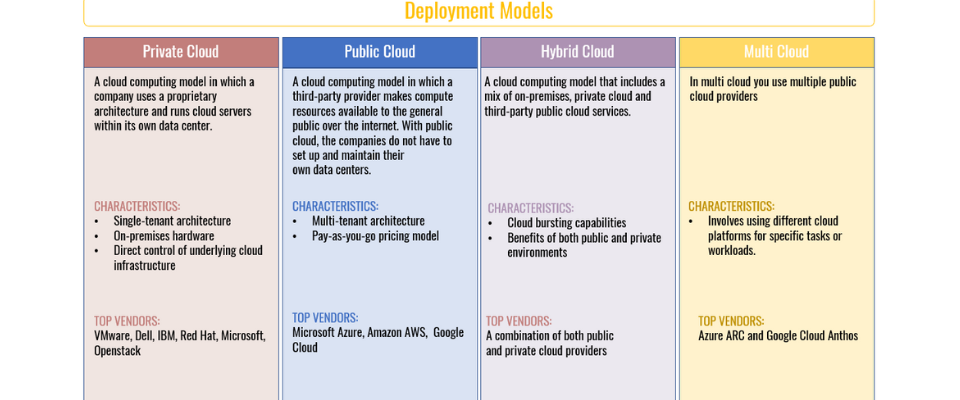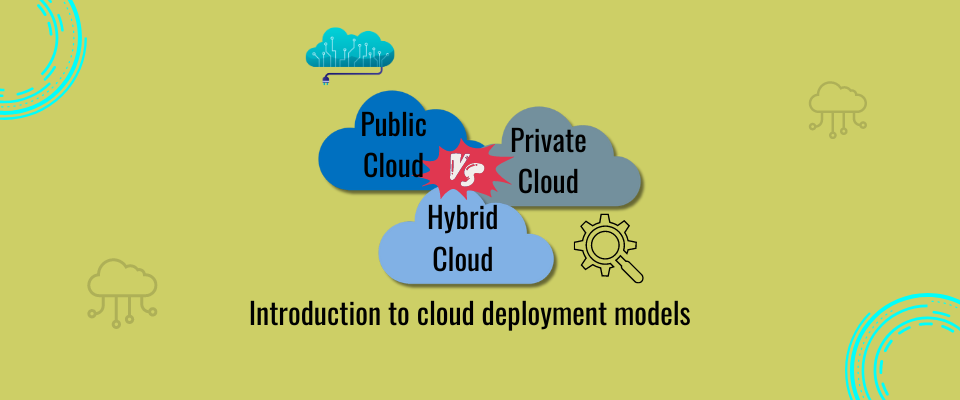Cloud - Concept
Cloud Deployment Models
What is Cloud Deployment Models?
A cloud deployment model refers to the way cloud computing resources are provisioned and made available to users or organizations. It defines how the underlying infrastructure of the cloud is managed and shared among different users. There are primarily four main cloud deployment models:
Types Cloud Deployment Models.
There are primarily four main cloud deployment models::
- Public Cloud:
- Private Cloud:
- Hybrid Cloud:
- Multi Cloud:
A cloud computing model in which a third-party provider makes compute resources available to the general public over the internet. With public cloud, the companies do not have to set up and maintain their own data centers. Users can access and use these services on a pay-as-you-go basis, and they don't need to manage the underlying infrastructure. Examples of public cloud providers include Amazon Web Services (AWS), Microsoft Azure, and Google Cloud Platform (GCP).
A cloud computing model in which a company uses a proprietary architecture and runs cloud servers within its own data center. Private clouds are often preferred by companies or government institutions that have strict security and compliance requirements and need more control over their data and resources.
A cloud computing model that includes a mix of on-premises, private cloud and third-party public cloud services. In a hybrid cloud, data and applications can move between the private and public cloud environments, providing greater flexibility and scalability.
In multi cloud you use multiple public cloud providers.

Benefits
Let's have a look at Advantages or Benefits of Public Cloud:
- Cost-Effectiveness:
- Scalability:
- Global Reach:
- Ease of Use:
Public cloud services operate on a pay-as-you-go model, allowing organizations to avoid upfront infrastructure costs. Users only pay for the resources they consume, making it cost-effective, especially for small and medium-sized businesses.
Public cloud providers offer virtually limitless scalability. Organizations can easily scale up or down based on demand, ensuring resources are efficiently utilized.
Public clouds have a wide network of data centers worldwide, enabling global deployment with minimal effort. This is beneficial for businesses with a widespread customer base.
Public clouds provide a user-friendly interface, making it easy for users to access and manage their resources without extensive technical knowledge.
Let's have a look at Advantages or Benefits of Private Cloud:
- Enhanced Security:
- Customization and Control:
- Predictable Performance:
Private clouds are like your own fortress of security! They give you full control over your data and resources, which is perfect for organizations that need to follow strict security rules and regulations. All your sensitive data stays safely within your organization's walls.
And that's not all – private clouds are totally customizable. You can set up the infrastructure and services just the way you want, tailoring everything to suit your unique needs.
As resources are dedicated solely to one organization, private clouds tend to provide more consistent and predictable performance, as there is no sharing of resources with other users.
Let's have a look at Advantages or Benefits of Hybrid Cloud:
- Flexibility:
- Disaster Recovery:
- Cost Optimization:
Hybrid clouds are like having the best of both worlds! They're super flexible, letting organizations get the perks from both public and private clouds. You can use public cloud for stuff that's not too sensitive, and keep the private cloud for all the important and critical tasks.
And here's the cool part – hybrid clouds are great for disaster recovery. You can back up all your vital data and apps in the private cloud, and if anything goes wrong, the public cloud steps in to save the day.
Not to mention, you can save a bunch of money too! By using the public cloud only when you need extra resources for temporary or busy times, you can keep your costs down while still having full control over your data in the private cloud. It's a win-win situation!
Let's have a look at Advantages or Benefits of Multi Cloud:
- Avoid Vendor Lock-In:
- Best-of-Breed Solutions:
- Increased Resilience:
With a multi-cloud strategy, you're free as a bird! You can dodge that pesky vendor lock-in, so you're not stuck relying on just one cloud provider. Switching between services and providers is a breeze, giving you the ultimate flexibility.
And here's the cherry on top – you get the best of the best! Different cloud providers rock in different areas. So, with a multi-cloud approach, you can cherry-pick the top-notch services from different providers that suit each specific task or app perfectly.
Last but not the least! Having multiple cloud providers beefs up your resilience big time. If one provider has a hiccup or outage, don't worry! Your crucial apps and services can quickly jump ship to another provider, keeping things running smooth as butter. It's like having a safety net for your cloud services!



